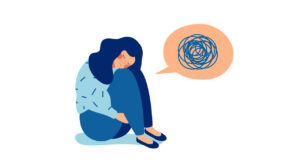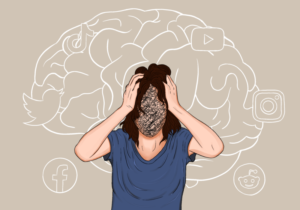Generalized Anxiety Disorder (GAD) is more than just everyday worry or stress; it’s a chronic condition characterized by excessive and uncontrollable anxiety about various aspects of life. If you or someone you know is struggling with GAD, you’re not alone, and there is hope for managing and overcoming this condition. In this article, we will explore therapy for Generalized Anxiety Disorder, shedding light on how it can help individuals regain control.
Contents
- 1 Introduction to Generalized Anxiety Disorder (GAD)
- 2 Types of Therapy for Generalized Anxiety Disorder
- 3 Step-by-Step Explanation of Therapy Sessions for GAD
- 4 Benefits of Therapy for Generalized Anxiety Disorder
- 5 Is Therapy for Generalized Anxiety Disorder Suitable for Everyone?
- 6 Finding a Qualified Therapist for GAD
- 7 Conclusion
Introduction to Generalized Anxiety Disorder (GAD)

GAD is a mental health disorder that affects millions of people worldwide. It is characterized by persistent and excessive worry about everyday life situations, often accompanied by physical symptoms such as restlessness, muscle tension, and sleep disturbances. Individuals with GAD may find it challenging to control their anxiety, leading to a constant state of unease.
GAD is more common than you might think. According to recent studies, it affects approximately 6.8 million adults in the United States alone. However, many cases go undiagnosed, making the actual prevalence likely higher.
The symptoms of GAD can be debilitating. They can interfere with work, relationships, and overall happiness. Understanding these symptoms is crucial to seeking the right treatment.
Types of Therapy for Generalized Anxiety Disorder
Several types of therapy can be effective in treating Generalized Anxiety Disorder (GAD). The choice of therapy may depend on the individual’s preferences, the severity of their GAD, and their specific needs. Here are some common types of therapy for GAD:
- Cognitive-Behavioral Therapy (CBT): CBT is one of the most widely used and researched therapies for GAD. It focuses on identifying and challenging irrational and anxious thoughts and replacing them with more realistic and balanced ones. CBT also includes behavioral techniques to help individuals gradually confront their anxieties.
- Exposure Therapy: This is a specific component of CBT. Exposure therapy involves facing feared situations or objects gradually and repeatedly to reduce the anxiety associated with them. It can be highly effective for specific phobias and social anxiety, which often co-occur with GAD.
- Acceptance and Commitment Therapy (ACT): ACT combines mindfulness and acceptance strategies with a commitment to values-based actions. It helps individuals accept their anxious thoughts and feelings rather than trying to eliminate them. ACT aims to increase psychological flexibility and improve overall well-being.
- Mindfulness-Based Stress Reduction (MBSR): MBSR is a structured program that teaches mindfulness meditation and yoga. It helps individuals become more aware of their thoughts and feelings, allowing them to respond to anxiety more mindfully and less reactively.
- Dialectical Behavior Therapy (DBT): DBT was initially developed to treat borderline personality disorder but has also been adapted for other conditions, including GAD. DBT combines cognitive-behavioral techniques with mindfulness and emotion regulation strategies to help individuals manage their emotions and reduce anxiety.
- Interpersonal Therapy (IPT): IPT focuses on improving interpersonal relationships and communication skills. It may be particularly helpful for individuals with GAD when anxiety is closely related to relationship conflicts or life transitions.
- Psychodynamic Therapy: This approach explores unconscious thoughts and feelings that may contribute to anxiety. It aims to help individuals gain insight into the underlying causes of their anxiety and develop healthier coping mechanisms.
- Biofeedback: Biofeedback involves the use of electronic monitoring to help individuals gain awareness and control over physiological functions like heart rate and muscle tension. It can teach individuals to manage physical symptoms of anxiety.
- Group Therapy: Group therapy involves sessions led by a therapist and attended by multiple individuals with GAD. It provides a supportive environment for sharing experiences, learning coping strategies, and receiving feedback from peers.
- Family Therapy: Sometimes, GAD can affect the entire family system. Family therapy can help family members better understand GAD, improve communication, and support individuals with GAD in managing their symptoms.
- Online Therapy: With the growth of telehealth, online therapy platforms offer various therapeutic approaches, making it convenient for individuals to access treatment from the comfort of their own homes.
Step-by-Step Explanation of Therapy Sessions for GAD

Therapy sessions for Generalized Anxiety Disorder (GAD) typically follow a structured and evidence-based approach, often guided by a trained therapist. Here’s a step-by-step explanation of what you might expect during therapy sessions for GAD, using Cognitive-Behavioral Therapy (CBT) as an example:
- Assessment and Goal Setting:
- The first session often begins with an assessment where the therapist gathers information about your history, symptoms, and current life circumstances.
- You and your therapist will discuss your goals for therapy. These could include reducing anxiety, improving coping strategies, or enhancing overall well-being.
- Psychoeducation:
- Your therapist will provide you with information about GAD, explaining its symptoms, causes, and how it affects your life.
- You’ll learn about the cognitive-behavioral model of anxiety, which focuses on the relationship between thoughts, feelings, and behaviors.
- Identifying Triggers and Patterns:
- You and your therapist will work together to identify specific situations, thoughts, and behaviors that trigger or maintain your anxiety.
- You’ll learn to recognize common cognitive distortions (e.g., catastrophizing, overgeneralization) that contribute to anxiety.
- Setting an Agenda: At the beginning of each session, you and your therapist will set an agenda for the session. This helps prioritize what you want to discuss and work on during the session.
- Thought Monitoring:
- You’ll be encouraged to keep a thought diary to record your anxious thoughts and the situations in which they occur.
- You’ll learn how to identify and challenge irrational or negative thoughts using evidence-based techniques.
- Behavioral Strategies: Your therapist may introduce behavioral techniques to help reduce anxiety. These may include gradual exposure to feared situations or activities, relaxation techniques, and time management skills.
- Homework Assignments: You might receive homework assignments between sessions, which could involve practicing techniques you’ve learned or applying them in real-life situations.
Benefits of Therapy for Generalized Anxiety Disorder
Therapy, particularly evidence-based therapies like Cognitive-Behavioral Therapy (CBT), can provide numerous benefits for individuals with Generalized Anxiety Disorder (GAD). Here are some of the key benefits:
- Symptom Reduction: Therapy can significantly reduce the symptoms of GAD. It helps individuals gain control over their excessive worry, restlessness, and physical symptoms such as muscle tension and insomnia.
- Improved Coping Skills: Therapy equips individuals with effective coping strategies to manage anxiety. They learn how to identify and challenge irrational thoughts and engage in healthier behaviors when faced with anxiety-provoking situations.
- Enhanced Self-Awareness: Therapy encourages self-reflection and self-awareness. Clients gain insight into their thought patterns, triggers, and how they contribute to their anxiety, allowing them to make positive changes.
- Stress Management: Therapy teaches stress-reduction techniques such as relaxation exercises, mindfulness, and deep breathing, which can be applied in daily life to manage stress and anxiety.
- Increased Emotional Regulation: Individuals learn to identify and regulate their emotions more effectively. This can reduce the intensity of emotional responses to anxiety and stress.
- Better Problem-Solving Skills: Therapy helps individuals develop problem-solving skills, allowing them to address life challenges and stressors more effectively.
- Improved Relationships: For individuals whose anxiety impacts their relationships, therapy can lead to better communication, conflict resolution, and interpersonal skills.
- Increased Confidence: As individuals make progress in therapy and see improvements in their ability to manage anxiety, their self-confidence and self-esteem often increase.
- Prevention of Complications: By addressing GAD through therapy, individuals can prevent potential complications such as the development of other mental health conditions or physical health problems associated with chronic stress.
Is Therapy for Generalized Anxiety Disorder Suitable for Everyone?
Therapy for Generalized Anxiety Disorder (GAD) can be highly effective, but whether it is suitable for everyone depends on various factors, including the individual’s preferences, needs, and the severity of their condition. Here are some considerations:
- Therapy Suitability: Therapy is generally considered suitable for most individuals with GAD. Evidence-based therapies like Cognitive-Behavioral Therapy (CBT), as well as other therapeutic approaches, are effective in treating GAD.
- Individual Preferences: Some people may prefer therapy as their primary treatment, while others may have reservations or prefer alternative approaches. It’s important to respect individual preferences and work collaboratively to find the most suitable treatment.
- Severity of GAD: The severity of GAD can vary widely. Mild cases of GAD may be effectively managed with self-help strategies, lifestyle changes, or less intensive forms of therapy. In more severe cases, a combination of therapy and medication may be recommended.
- Comorbid Conditions: If an individual with GAD has other co-occurring mental health conditions, such as depression or substance abuse, their treatment plan may need to address these conditions as well. Therapy can be adapted to address multiple concerns.
- Accessibility: Access to therapy can vary depending on location, financial resources, and insurance coverage. Some individuals may face barriers to accessing therapy, and alternative forms of support, such as self-help resources or online therapy, may be more accessible.
Finding a Qualified Therapist for GAD

Finding a qualified therapist for Generalized Anxiety Disorder (GAD) is an important step toward managing and treating your condition effectively. Here are steps to help you find a qualified therapist for GAD:
- Consult with Your Primary Care Physician: Your primary care doctor can be a valuable resource. They can provide referrals to therapists or psychiatrists who specialize in treating anxiety disorders, including GAD. They may also perform an initial evaluation to rule out any medical conditions that could contribute to your symptoms.
- Contact Your Insurance Provider: If you have health insurance, check with your insurance company to understand your mental health coverage. They can provide a list of in-network therapists, which can help you save on costs.
- Ask for Recommendations: Seek recommendations from trusted sources, such as friends, family members, or colleagues, who have had positive experiences with therapists. Personal referrals can be a good starting point.
- Online Directories: Utilize online directories and databases that list therapists and their specialties. Some popular resources include Mantracare and Therapymantra.
Conclusion
In conclusion, Cognitive-Behavioral Therapy offers a promising path to managing and ultimately overcoming Generalized Anxiety Disorder. While GAD can be overwhelming, it’s important to remember that there is help available, and many have successfully reclaimed their lives through CBT.
If you are experiencing anxiety related issues, Online Anxiety Counseling at TherapyMantra can help: Book a trial Online therapy session.


